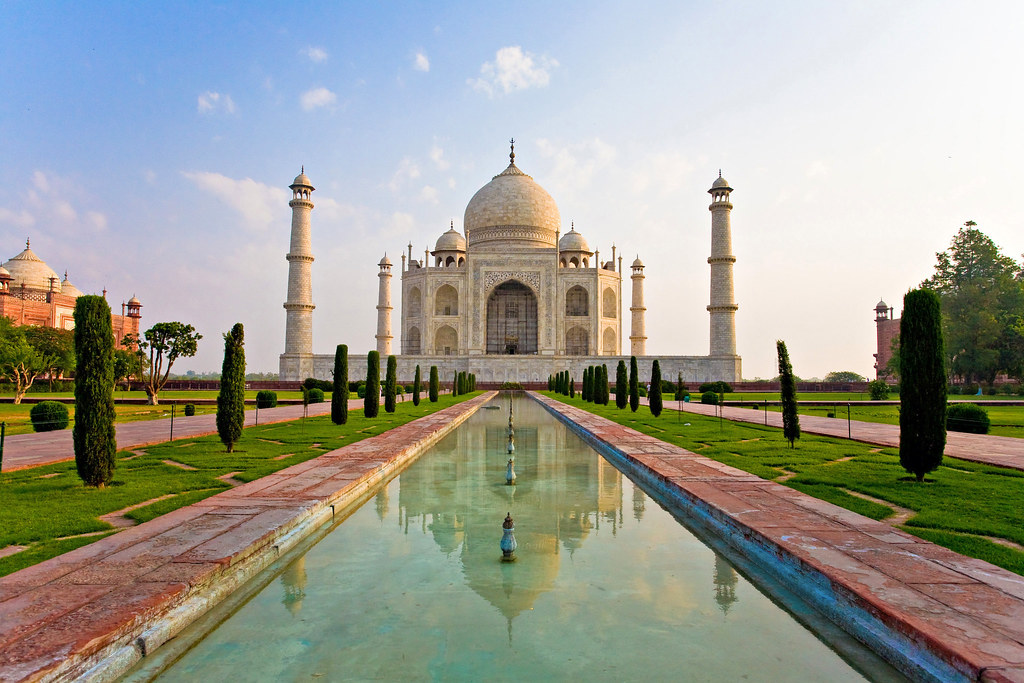We spent a month in India. We went to many places: New Delhi, Varanasi, Agra, Fatehpur Sikri, Jaipur, Mandawa, Bikaner, Jailsamer, Jodhpur, Udaipur, Munnar, Alappuzha, Ajanta, Elora and Mumbai. We saw many things that wowed us, largely positively, sometimes less so.
The hygienic norms were … different. Many people walked barefoot in cities in which the ground was strewn with the dung of the ever-present holy cows that roamed the streets, their expressionless, downcast eyes and calm demeanors suggesting they had already attained a substantial measure of the enlightenment of which the rest of us were still scurrying about in pursuit. Yellow, black, and brown stains on hotel sheets and towels were commonplace. Public restrooms at tourist sites often lacked toilet paper, with floors frequently looking and smelling like swamps. People ate with their fingers, not always washing them beforehand. Strangers gulped down water out of shared bottles and vessels. Street vendors and food servers routinely touched our food with their bare hands, on one occasion, right in front of us, even fishing out some sort of foreign particle that had found its way in before proceeding to present the rest for our consumption. The implicit Western norm positing an invisible, roughly one-foot bubble of personal space within which each of us could move about was non-existent.
We took it all in stride and preferred to observe rather than judge. We took care to avoid drinking or brushing our teeth with the bacteria-infested tap water known to send unaccustomed foreigners to sickbeds, but we ate street food galore — samosas, kachoris, dal pakwans, pav bhajis and vada pavs, rabris, badam milks, kesar milks and malaiyos, and the ubiquitous masala chais — in markets, in networks of back alleys as-yet-uncharted by Google Maps, street food dirty as it was delicious, with plates washed from hoses aimed into grimy tubs planted on the dusty ground. We downed antibacterial, antiparasitic oregano oil capsules with nearly every meal to stave off infection, and the trick worked. We stayed healthy and happy, freely immersing ourselves in our culinary and cultural surroundings as best we could rather than, as many Western travelers we met, sticking to sanitized, spiced-down hotel restaurants and fine dining establishments that put their occupants in the position of tourists on safari observing the dangerous animals from the comfort of air-conditioned buses.
We deferred to local practices, howsoever foreign they seemed to us. This was not our country and, what is more, was the modern-day outgrowth of a great ancient civilization that had given the world so much, including two of the planet’s five major religions. Though the Indians’ sanitary practices diverged starkly from ours, the people here were, nonetheless, not dropping like flies. Something here was working in its way… and maybe more than just something. There was, we had concluded well before the tail-end of our journey, much here that was working very well indeed.
Most starkly, in an entire month of traveling through India, we had seen not so much as one single loner using drugs or strung out in the streets. At no point did we catch even a whiff of the skunk-like stench of marijuana that has become a fixture since its actual or effective legalization throughout American cities. Perhaps still more shockingly, we did not see anyone exhibiting signs of intoxication. Even cigarette smoking was rare to behold. We witnessed a grand total of one madman muttering to himself, not the parade of deinstitutionalized mental patients posing dangers to themselves and others that we are accustomed to navigating around in New York City streets and subways. Public transportation — railway trains, buses, the metros in Delhi and Mumbai — were clean and orderly, and even where people were squeezed in tight, they behaved normally and respectfully. Each person took up only a single seat — there was no sign of our homegrown human hippos with cabooses splayed out across multiple seats — nor was there any sign of the kind of boorish behavior now commonplace in U.S. public transportation networks: people with feet up on the seats or louts refusing to use headphones to keep their primitive, profanity-laced music to themselves. We saw plenty of poor people living on the streets and were accosted by annoyingly persistent panhandlers, including panhandling children galore, but there was not a single moment when we felt remotely endangered. Duly ignored, the panhandlers eventually conceded defeat and set off in search of their next targets.
In every city we visited, we felt completely safe. We heard tell that in the North and Delhi in particular, there is a history of crimes against women, and the men do tend to stare at women, especially foreign women, as though they have never seen one before, so dressing modestly in accordance with local customs is the safer (and more respectful) route to go, but we never felt any active threat. The Modi government, we were told, has made women’s safety and empowerment an especial focus. The metal detectors and pat-downs at temples and monuments always included a separate line for women, and even the Delhi metro, which also requires passengers to pass through a metal detector and bag check on the way in (an idea that may sound appealing to many NYC-subway riders about now), has a women-only car.
We were struck, as well, by how many people, expecting nothing in return, were eager to be helpful and kind. Virtually every time we were peering at the maps apps on our phones or squinting into the distance to find street signs (a relative rarity in India), a stranger would approach us and ask if we needed help to find something, and those in the customer service industry were almost always ready to bend over backwards to ensure all our needs were accounted for. Security personnel at monuments and airports were appropriate and courteous to a fault. Whether in these places, where large masses of people were quickly and efficiently processed into a steady flow, or on the dusty, rough-hewn roads, inevitably bereft of traffic signals and sidewalks, where a dizzying gallimaufry of cars, buses, trucks, rickshaws, motorcycles, cows, goats, dogs, and pedestrians maneuvered slowly but surely among stalls and hawkers, among haphazardly parked and paused vehicles and across sketched lanes that seemed like mere suggestions, the chaos simply worked. Drivers used their horns to signal their presence and intentions, and in every city, a ceaseless cacophony of gentle honks meant things were moving along in their usual course. No one was glued to phones — instead of invoking any absolute right of way, pedestrians would cross streets by winding among vehicles, feeling their way forward in a kind of rhythmic dance that required full attention to the closing speed, distance, and cadence of traffic oncoming from every direction. Drivers, as well, deferred to one another as needed, following implicit codes rather than explicit rules to intuit an order of priority. We noticed after some time that hardly a car in India had bumpers, and yet dents, nicks, and scratches were almost nowhere to be found. We asked one guide how it could be that our cars at home, bumpered off from one another and maneuvered largely in rigid straight lines, were nonetheless so frequently dinged up, and yet here, with such seeming chaos all around, the cars were much more frequently undamaged. “Are your drivers that bad?” was his very sensible response.
The one abiding, overarching norm differentiating India from the United States and much of the West that accounted for all the underlying differences, both positive and negative, big and small, that we observed may be summarized in a single word: community. This word was mentioned quite often in our travels, with guides in many of the places we visited invoking it in answer to our queries. In contrast to the rugged individualism characteristic of the West and especially of our pluralistic, multi-ethnic, multi-racial, multi-religious American homeland — the ethos of which was established by its founding dissenters and nonconformists unable to make do among their erstwhile compatriots in their respective motherlands — India is a place in which, its religious divides notwithstanding, communal life takes precedence over individual self-determination. Echoing the “all is One” foundation of its dominant religious tradition, everything from the lack of respect for personal space to the seemingly heedless sharing of drinking vessels with strangers to the readiness to offer help to others in need may be explained by the abiding presence of a more close-knit union among the people of this land.
Even marriages—over 90% of which are arranged— represent a bond not between individuals but between families sharing a common caste. Many Indians we spoke to about the subject touted the advantages of such marriages. In love marriages, when the love goes, the marriage commonly follows. Two people drawn to each other by animal magnetism wear rose-colored glasses shielding them from confronting the difficult nuances of getting along, but when the rosy hue subsides, as it must, the sober light of day reveals all the problems and areas of incompatibility that the couple now feels little compulsion to resolve. By contrast, in arranged marriages, the betrothed pair starts off with no illusions: they are virtual strangers whose very task is to bridge a gulf, resolve differences, and build a relationship that works. Though they may rarely attain the oft-quixotic Western ideal of “soulmates,” and though they may frequently occupy somewhat separate spheres of existence dictated by gender norms, they, their parents, and their children will be content, unburdened by unrealistic expectations. Surveys show, in fact, that the couples in such marriages are no less or even more satisfied than couples in love marriages, and the divorce rate in arranged marriages is far lower—with India’s divorce rate as a whole being 1% in contrast to the 40-50%-range that prevails in the United States.
Divorce, we were told, is widely viewed as shameful in India, and the shame extends beyond the two individuals who choose to break their bond. The decisions of individuals redound upon families. This is part of the reason, as several tour guides explained to us, why public spaces in India were almost entirely free of miscreants. A person high or intoxicated in public shames his family, not just himself. But familial and communal life addresses the same kinds of issues from a different standpoint as well: people with problems, whether substance abuse or mental illness or their all-too-frequent intersection, are cared for by their families rather than, as often happens in our nation of broken families, being left to their own devices, whereupon they become blights upon entire cities and communities.
Just over a month after our departure for India, we touched down in Newark, New Jersey, only to witness a kind of punctuation mark bringing to a point the lessons of our overseas experience. A sadly stereotypical scene unfolded before us. Some half of the passengers on our flight, us included, had not received all their luggage due, apparently, to luggage having been offloaded back in Mumbai in anticipation of expected turbulence. A crowd of people descended upon a small counter to fill out baggage claim forms. Instead of organizing the claimants into an orderly line from the outset, airport workers had let the passengers mass at the counter. Then, suddenly, a heavyset black woman emerged and began aggressively shouting instructions to everyone in a brusque tone, demanding that everybody “just back up!” and get in line. But passengers exhausted from a nearly 17-hour flight and itching to fill out their claim forms and leave the airport were none too eager to step back and relinquish their priority—especially as the woefully understaffed process was creeping along at a snail’s pace. Soon thereafter, the aggressive employee’s ire came to be focused on one particular Indian man who was refusing to step back, as he was insisting he had joined the queue before various others who stood to gain by his deferral. The employee huffed and puffed and shouted at him, threatening to call security, insisting he was yelling at her even though, from my vantage point some 20 feet away, I could hear her every rude word yet could hardly hear a thing the man was calmly but insistently saying in response. I didn’t stay to witness the resolution of the incident as she made good on her threat to summon security personnel. One thing was clear: we were back in the good ole U.S. of A.
That would become still clearer in the coming days as we re-acquainted ourselves with the depressingly familiar realities of our city: the addicts stumbling and keeling over in the middle of the streets, the malodorous bums sprawled out in cracks and crevices and on trains and in stations, the lounging, looming, and swaggering thugs jumping subway turnstiles, filling up train cars with cigarette smoke, resting their feet on top of the seats, making most in their midst feel unsettled and unsafe in ways great and small. And we saw, still more palpably, the indulgence, fear, and apathy of a society that, by refusing to punish crime and tolerating and even hosting the use of illicit drugs in plain sight, declined to confront the problem, letting its worst run riot, free to terrorize the rest.
We spent a month in India. To understand the inner workings of a complex society takes not a month but a lifetime. Ours, of course, is a tourist’s take on India. For tourists, a nation tends to put its best foot forward. Nearly all of the guides and most of the people we met, for example, expressed strong support for the nation’s current Hindu nationalist government, but we know the feeling is not universal, especially among the nation’s Muslim minority. A highly communitarian society, moreover, is not without its problems of the sort felt most acutely by those individuals who recoil against its governing norms, such as the role of the caste system in their lives, or those persons, such as women stuck in abusive marriages, entrapped by tight-knit bonds that become chains held fast by pressure, guilt, and shame. Nor is America’s individualism—our live-and-let-live attitude, with our profound respect for individual freedom and self-determination—a solely or even predominantly negative attribute. Such freedom is our calling card, the wellspring of our dynamism, the very reason that, for centuries now, talented immigrants the world over have flocked here in search of a better life and contributed enormously to our collective good.
And yet, there is no escaping the feeling that the wheels have come off, that—just as our immigration policy has morphed from formally inviting others to get in line to contribute to a feast to opening the floodgates for rulebreakers eager to tear into a free-for-all—our historical tolerance for otherness has crossed over into a pathological disdain for self, for the foundational figures and principles that made us what we are. It is in that light that India’s communitarian model has something to teach us. We need not, cannot, and never would go all the way to any such extreme. But forging a path toward a middle ground would give us a start on regaining what we have lost.
Image via Flickr








1 comment
Brian
Thank you for sharing. I’ve had several Indian colleagues tell me I have to come visit and say things like, “you have to experience the colors, the smells”, which doesn’t exactly make the most compelling case…
The state of US cities is a choice, a deliberate choice not made by the American people but by our rulers. Cities were well functioning places 70 years ago, and then were systematically destroyed by government policies. And if you note that one political party has 90% vote share over every major city, you can either be cynical or realistic enough to have complete confidence that there will be absolutely nothing done about it.
The problem is that America moved almost overnight due to WWII from a country with quite small and distant governance to one with an extremely powerful centralized bureaucratic government, and the people didn’t have a clue how to respond to prevent it. A culture of “leave me alone” or “I’ll just light out for the frontier when things get too cramped” is completely inadequate for fighting Leviathan.
Comments are closed.